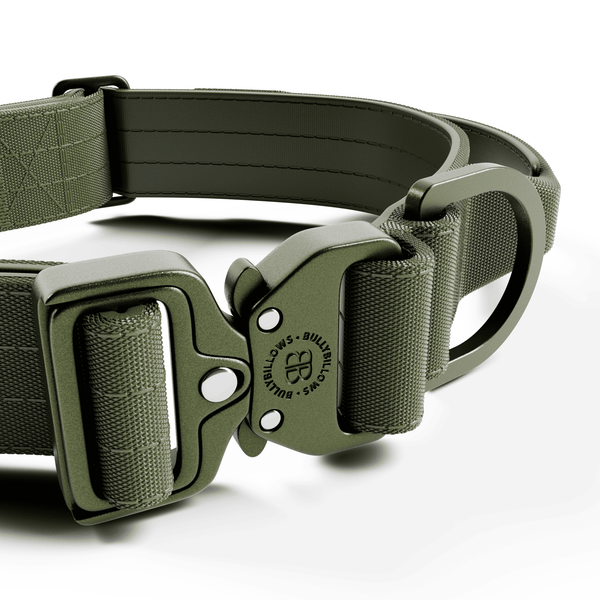As the proud owner of two pups from the same litter, you're in for an incredibly rewarding experience. Not only will it be double the fun, but it's heartwarming to see them grow up so close to each other. However, you should also be aware of the potential risks associated with raising littermates, including a condition known as littermate syndrome.
In this article, we'll cover everything you need to know about littermate syndrome, from what it is and how it's caused to the symptoms and long-term effects. So, whether you're considering adopting littermates or already have them, this guide will provide you with the knowledge and tools you need to ensure a happy and healthy life for both pups.
Read on to discover everything you need to know about littermate syndrome…

What is littermate syndrome?
Littermate syndrome (also known as littermate aggression) can be defined as a behavioural condition that can impact the social development of dogs. Generally speaking, it’s when two dogs from the same family are raised in the same home and form an unhealthy reliance on one another.
This bond can be seen as quite sweet at first, but the problem is that it becomes much stronger than what they have with anyone, including you. So, what does this mean?
Aggression, separation anxiety, fiercely protective tendencies and disruptive behaviour are all telltale signs of littermate syndrome. It’ll usually be more apparent if you try to separate them, even briefly. We’ll be going into more detail on spotting whether or not littermate syndrome has developed later in this article.
So, when you choose to home two dogs from the same litter, there’s a higher chance that they’ll bond so strongly with one another, making it difficult for them to form a bond with you. Now, that’s not to say that they can’t form an attachment to you - it’ll just likely be the case that they’ll place each other first on their priority lists.
Do specific dog breeds have a higher likelihood of developing littermate syndrome?
Certain breeds are associated with more intense attachment behaviours, but there is no concrete evidence to suggest that littermate syndrome is breed-specific, meaning it can develop between any dog breed, including mixed breeds.
At what age does littermate syndrome start to develop?
You can usually expect signs of littermate syndrome to develop when the puppies reach roughly eight to ten weeks of age.
This can vary somewhat, as it may only become apparent when pups are taken home for the first time. And, as that’s usually around the 8-week mark, that’s when littermate syndrome indicators start to reveal themselves.
So, for example, if you adopt two slightly older pups, say around six months old, littermate syndrome can also develop in their adolescence and become more apparent as they grow older.

What causes littermate syndrome?
In short, littermate syndrome is caused by several factors that stem from raising two puppies in the same household.
The familiarity the puppies already have can cause the pair to become overly reliant on each other, which ultimately leads to a lack of independence and socialisation with other dogs and people.
What usually causes littermate syndrome to fully develop is a lack of intervention. Suppose it’s not recognised, and the puppies are not given enough individual attention and training. This can stunt the duo from developing their own distinct personalities, resulting in a stronger co-dependence. They’ll see each other as one!
So, what does this mean? It means the pups will never have had to cope with how new situations and experiences feel without each other, which can cause them to reject ever exploring that possibility entirely.
To summarise the above, you can’t prevent littermate syndrome from happening if you’re unaware of the signs. And allowing littermate pups to continue to nurture their dynamic without intervention is the root cause.
That’s why if you adopt a pair of littermates, it’s incredibly important to encourage them to learn without each other, making a conscious effort to allow the pups to find their own voice and personality.
And, trust us, we know it’s so easy to consider signs of littermate syndrome as ‘cute’ because it usually does appear that way at first. The problem is that it will cause them to face behavioural and social challenges for (potentially) their entire lives, so intervening is in their best interest.
Is it possible to prevent littermate syndrome?
Yes, it’s entirely possible to prevent littermate syndrome.
Of course, you’ll have a more challenging job on your hands when adopting two pups from the same family or even unrelated dogs but of a similar age. But that doesn’t mean to say that there aren’t any actions you can take to stop this behavioural condition from developing.
Do dogs have to be siblings to develop littermate syndrome?
Not always; we just see it more in pairs of siblings that are adopted and raised in the same household. But, if you were also to adopt two pups close to around the same age, littermate syndrome can also develop.

Do all dog siblings raised in the same household develop littermate syndrome?
Interestingly, no. It’s not accurate to say that all furry siblings duos raised in the same household will go on to develop full-blown littermate syndrome. The best way to think about it is that it’s more of a risk than a guaranteed outcome.
The concern around littermate syndrome is that it’s common enough for it to be noted as a potential outcome by many professional dog trainers and vets. So, although it may not be true for some people, that doesn’t mean it won’t happen.
How common is littermate syndrome?
This is the kicker. Because littermate syndrome can’t be defined as an ‘official’ medical diagnosis for pups, there’s not much research out there that can accurately showcase how common it is for pairs of pups to experience this behavioural condition.
But, many professional dog trainers and veterinarians across the globe have publicly spoken about littermate syndrome and agree that it's a common issue seen among pairs of young dogs.
For example, Dr Ian Dunbar, a renowned veterinarian, animal behaviourist, and dog trainer, openly acknowledges and discusses the challenges that can arise with littermate syndrome. He’s been known to highlight how it can be tough on new dog parents and provides insights on preventing and managing the condition from becoming a bigger problem.
So, is littermate syndrome even real?
There’s no denying the frequency of similarities between those who adopt littermates. However, the question remains up for debate as to whether or not it’s a real condition or more of a myth used to explain the unexplainable.
This question has torn experts for many years. Some will say that it’s not diagnosable and, therefore, it can’t be accurately used to explain certain behavioural challenges, whereas others argue it’s much more common than most people think, and the fact that they see this pattern regularly is enough proof in itself to deem it very real.
What type of dynamic can you expect to see with littermate syndrome?
You’ll typically see a pair of pups that are inseparable in every capacity. They’ll eat, sleep, walk, explore, and play together. And, although this dynamic is entirely based on co-dependency, there’s usually a more dominating pup. In other words, the leader of the pack.
You’ll likely catch them hiding out with one another, keeping themselves to themselves. Calling out to them will be pointless as they’ll only likely take direction from each other. The more submissive pup out of the two will look to the more dominant pup for guidance.
They’ll be completely bonded to the point where they’ll only ever venture anywhere without the other, and interaction with other dogs won’t be enjoyable. They’ll still maintain a bond with you and accept affection, such as a stroke or cuddle, but not without the other pup close behind. And, if they are separated, even for a short time, littermate pups will become increasingly distressed and frantically look to find one another.
In addition, littermate syndrome can also lead to inter-dog aggression, despite the incredibly strong bond and reliance on each other for support. This is when littermates become aggressive towards each other due to sibling rivalry. So, this usually means that what starts as innocent playtime can escalate as they grow a little older.
What’s more, inter-dog aggression doesn’t just stay between siblings. As littermate dogs usually only show a willingness to socialise with each other, when an unfamiliar dog enters the scene, it can trigger hostile reactions from the littermates, either from a place of fear or aggression. As a result, pups with littermate syndrome may team up and become overly aggressive when encountering an ‘outsider’ dog or simply run and hide!
Can dogs ever grow out of littermate syndrome?
Yes. Dogs can grow out of littermate syndrome and go on to form healthy, strong bonds with other pups and humans. However, they can’t do it on their own.
Getting your dogs to grow out of littermate syndrome will be a process that requires a great deal of patience, effort and love. But we promise it’s worth it. The good news is that if it’s dealt with head-on, there’s no reason why your pups can’t go on to learn how to socialise and bond with others.
What are some early signs of littermate syndrome?
As mentioned earlier, we can't define behaviours as symptoms because littermate syndrome is not a medical diagnosis. But, there are several early telltale signs that your puppies are beginning to develop littermate syndrome, which include (but are not limited to):
- Ignoring basic commands from you or any other caregiver in the household.
- Littermate syndrome pups may come up to you for affection, but you may notice that it’s never on a one-to-one basis and only as a pair.
- Physical reactions to new people, dogs or situations. For example, your puppies may start to shake, show subtle signs of aggression or retreat entirely.
- Absolutely no interest in socialising with other dogs.
- If separated, your pups may begin to excessively bark, cry or whine until they are reunited.
- Lack of interest in doing anything without the other pup present. This can look like only eating, sleeping, playing, walking or showing a willingness to learn new commands together.
Will getting another dog help?
Sometimes, it can help, but it depends entirely on your unique pups. And if you were to adopt a third, it would need to not be another puppy but an adult dog.
This may allow your pups to learn patience and not to fear other dogs, as they’ll likely see an older dog as the new leader of the pack, allowing them to develop social skills outside of their duo. But be aware that inter-dog aggression will be a factor you must keep in mind here.
We advise you not to adopt another dog purely because your pups have developed littermate syndrome. Only do so if it’s what you want and you have the time and financial resources to accommodate three furry companions.

What’s the biggest misconception about littermate syndrome?
There are a few, but the biggest misconception with littermate syndrome is that they don’t value you. Littermate syndrome pups can, and will, bond with their owners - it’s just that they’ll place each other in a higher regard.
Other common misconceptions associated with littermate syndrome are that it can’t be rectified or that a bit of separation will ‘fix’ the problem entirely. Neither of these factors are true.
Littermate syndrome can be prevented, and it can also be addressed if it already has had time to develop. Consistency is key to this behavioural condition. With a little time, guidance, patience and proper training, pups can overcome littermate syndrome entirely.
Behavioural complications associated with littermate syndrome
It’s worth mentioning that littermate syndrome varies from duo to duo, and some of the factors mentioned below may be stronger than others, depending on the pups.
We know that learning everything there is to know about littermate syndrome can feel a little overwhelming, and you may be wondering what the actual behavioural complications around this condition are. So, let’s take a closer look at what they can look like.
Co-dependency
Co-dependency is quite extreme, usually meaning that all experiences are shared.
We’ve mentioned co-dependency throughout this article, but it’s one of the most obvious signs that littermate syndrome has developed between pups. Plus, this dynamic can also present itself in various ways.
Behavioural complications specific to co-dependency can look like only participating in an activity when the other pup is also on board, with close and constant proximity to one another. And as this can safely be defined as an excessive attachment, you’ll also be able to very obviously spot that they will have a strong preference for each other over anyone else.
So, trying to get two pups who have developed littermate syndrome to do absolutely anything without the other can feel like a struggle. They’ll be fiercely protective of one another and try to prevent being separated at all costs. Pups will also only look to each other for emotional support if they have developed littermate syndrome, meaning that they will only be able to feel true comfort from each other.
Moreover, untreated co-dependency in littermate syndrome can be heartbreaking, especially if the two dogs grow old together. Suppose one of them passes away before the other. In that case, the remaining pup can feel an overwhelming sense of helplessness, which is something no dog parent wants for their pet. This is one of the many reasons why early intervention is crucial.
It is important to teach your dog that it is okay to seek comfort from you, which will help them to overcome this upsetting situation. Additionally, encouraging your dog to form bonds with other canines can minimise feelings of loneliness and prevent future co-dependency issues.
Separation anxiety
Co-dependency and separation anxiety almost go hand in hand. But, some behavioural tendencies are more commonly associated with when a dog feels separation anxiety, and they’re worth looking out for.
If you separate two pups with littermate syndrome, you might notice that they will both start to become increasingly unsettled. It doesn’t tend to lead to aggression towards you, and instead, it can look more like genuine distress due to feeling insecure about their surroundings without the other pup present.
For example, chewing on furniture, excessive and repetitive barking, howling, digging, pacing and whining are all common behavioural signs that your pups are incredibly anxious over being separated.
Problems with training and obedience
Training one puppy is a task in itself. But two? And with littermate syndrome? You’ll definitely want to be ready to face some little bumps in the road.
Teaching littermate pups how to be obedient and well-behaved is quite a significant challenge. This is mostly down to their dependency on each other, which usually results in them feeling like they don’t need to take direction from anyone else.
So, what types of behaviours do we commonly see when trying to train puppies that have developed littermate syndrome?
They’ll both likely appear very distracted and almost like they cannot focus on human interaction with active training sessions. They may even show signs of downright resistance, too. This may present in behaviours such as becoming frustrated or anxious and even trying to take themselves away from the situation.
Another behavioural reaction when trying to train littermate pups is that sometimes you may feel like you’ve had a breakthrough, and they will actually listen to you regarding basic commands. However, this will likely be inconsistent, with some days being better than others.
Confidence is another key problem when it comes to training. Your pups may not trust the situation, as it’ll feel unfamiliar. They may become overly vigilant of their surroundings and feel insecure about the interaction that’s taking place.
This is especially true if you’ve sought a professional trainer, as this person will be a complete stranger to your pups. So, they may show signs of aggression or defensiveness, which can look like snarling, showing their teeth to the trainer, or in extreme cases, lunging forwards and backwards in an attempt to assert dominance over the situation.
And, if you attempt to train the pups separately, the lack of focus we discussed above will become much more apparent. Whining, barking, and refusal are all common behavioural responses to trying to train littermate pups separately, as they’ll be so accustomed to seeking guidance from each other.
Socialisation
Socialising pups that have developed littermate syndrome isn’t impossible, but the hardest battle you’ll have is getting them to show an interest in doing so!
There will be a level of fear towards other dogs simply because they are unfamiliar. This may mean your pups become completely avoidant and ignore other dogs entirely, or it can become a little more challenging.
Inter-dog aggression doesn’t live in isolation between sibling pups. If they feel overwhelmed, your dogs may begin to show aggression towards other dogs, either as a team or the more dominant pup will take charge.
In extreme cases, dogs that have developed littermate syndrome will bite other dogs if they feel threatened enough, so it’s very important to always keep an eye on how a situation progresses when introducing your dogs to new friends.
Cognitive development
Littermate syndrome can sometimes cause delayed cognitive development. What this may look like is that your pups will find it hard to learn any new skills whatsoever due to their unwillingness to participate in activities or training without the other present.
Another behavioural factor associated with delayed development is their ability to problem solve. A dog that hasn’t developed littermate syndrome can rely on their natural instincts to suss out a situation and sometimes simply use basic common sense to navigate new experiences and environments.
On the other hand, dogs with littermate syndrome may find it difficult to solve problems or make decisions independently. This may be as simple as getting one of the pups to play. For example, If you place a toy in front of a dog with littermate syndrome, they may not even react. Instead, they’ll likely look to the other puppy for guidance on what to do next.
Inter-dog aggression and resource guarding
We touched on inter-dog aggression briefly towards unfamiliar dogs in the socialisation section of the article, but an intense sibling rivalry can also lead to increased aggression towards one another as they grow older.
Those who have experienced inter-dog aggression between littermate syndrome puppies tend to find it difficult to manage. The main problem is that these fighting tendencies are unpredictable and can quickly escalate, leaving dog owners feeling helpless.
The main culprit behind this is usually resource guarding. Feeling possessive over items, toys, food and even you. These are the main causes of aggression for dogs with littermate syndrome, as the pair may have heightened feelings of territorial aggression over things they classify as important.
What happens when littermate pups get older?
If littermate syndrome pups are left without intervention, it can be really difficult to correct when they’ve reached maturity ( roughly two years of age).
This is because, at the point of adulthood, these behaviours will have become deeply ingrained, which will be much more difficult to manage. At this point, your dogs won’t be tiny little balls of cuteness anymore - they’ll be fully grown adult dogs with a lot more strength and dominance behind them.
And, as your pups grow and mature, signs of rivalry can become much more obvious. This is a natural part of a dog’s development, but with littermate syndrome, this can manifest into overly protective and territorial behaviour. So, what may have been playful roughhousing as puppies can now seem a bit more serious or even threatening.
So, all of those behaviours we discussed earlier as signs of littermate syndrome, such as inter-dog aggression, separation anxiety, resource guarding, co-dependency and an unwillingness to socialise or be trained, will all become almost a part of their personality, which is hard to change once they are considered adults.
That’s why it’s incredibly important to know about littermate syndrome early and take steps to manage potential conflicts. Because with proper training and attention, you can help your pups navigate this stage of their development and maintain a happy and healthy relationship with each other.

How to prevent littermate syndrome
Setting boundaries and routines early on is the best way to prevent littermate syndrome.
The best way to think of littermate syndrome is as an insecurity. These two pups have left all they’ve ever known to start their new life with you. So, naturally, littermate syndrome is more likely to develop if these feelings of insecurity aren’t addressed.
So, our advice would be to work on eliminating that worry for them, letting them learn that they can trust you to look after them without worrying about depending on each other for everything.
Of course, it can be a little easier said than done, and your experience will depend on your dogs. Sometimes, people can easily prevent littermate syndrome from developing, whereas it may be a little more challenging for others.
Here are several ways to help prevent littermate syndrome:
- You’ll see a common theme throughout our advice: practice doing daily tasks with your dogs separately and early on. The key here is to reaffirm that it’s okay to not have to be in close contact with each other all the time.
- This means, along with doing all the normal and necessary things together, finding time to do these things separately. Walks, playtime, eating, the lot.
- Try to spend as much quality time with each dog as possible. This will allow them (and you) to form a stronger bond, naturally allowing them to become less reliant on each other.
- Socialise your puppies separately. This needs to be a regular part of their routine early on. They must learn to trust other interactions without seeking reassurance from their other half!
- Remember to take it easy on yourself. Training one puppy is hard for most, so two is double the trouble! Patience for yourself is just as important.
- Increase the time they spend apart. Do this slowly throughout the first six months of their life. But don’t overdo it, as this can induce separation anxiety. Short periods (e.g. a short solo walk) are more than enough at the start, and gradually build that up.
- Organise professional and regular training sessions quickly. This is especially important to have in place within the first six months as it’ll be crucial for their development.
- Always remember to reward good behaviour. For your puppies to understand that behaviour is positive, they need to feel praise from you. So, for example, if your puppy is food-orientated, reward them for milestones with their favourite treat.
- Seek expert advice if you need someone to lean on for support with littermate syndrome.
BullyBillows: the home of premium quality dog gear
We hope you’ve found our article on littermate syndrome useful. And if there’s one thing you take away from this blog post, let it be that littermate syndrome is preventable if dealt with head-on!
So, if you’re in doubt, seek guidance from your vet or a reputable dog trainer. Especially if you’re a new dog owner, you won’t have all the answers - and that’s okay. So, reach out to professionals who can help you on your journey of raising two young pups in the healthiest way possible.
And remember, at BullyBillows, we offer a wide range of top-quality gear to help make training and socialising a much easier and more enjoyable experience. From leashes and collars to quality harnesses and everything in between, we have everything you need to raise a happy and healthy duo of pups.





























































